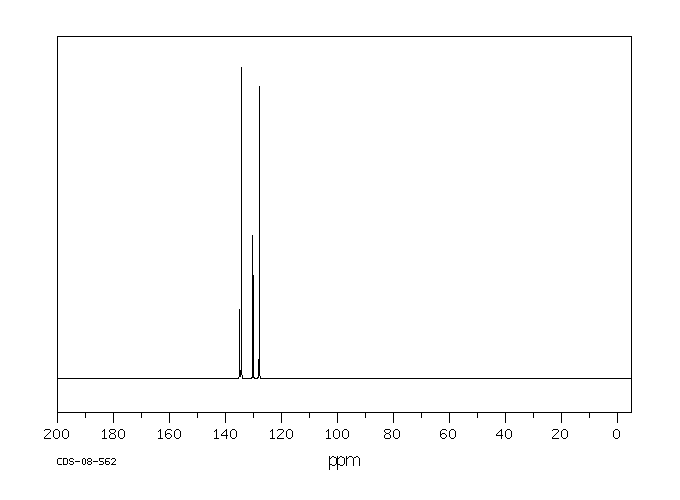二硅氧烷,1,1,3,3-四苯基- | 15545-80-9
中文名称
二硅氧烷,1,1,3,3-四苯基-
中文别名
——
英文名称
1,1,3,3-tetraphenyldisiloxane
英文别名
Diphenylsilyloxy(diphenyl)silane;diphenylsilyloxy(diphenyl)silane
CAS
15545-80-9
化学式
C24H22OSi2
mdl
——
分子量
382.609
InChiKey
SCTQCPWFWDWNTC-UHFFFAOYSA-N
BEILSTEIN
——
EINECS
——
-
物化性质
-
计算性质
-
ADMET
-
安全信息
-
SDS
-
制备方法与用途
-
上下游信息
-
文献信息
-
表征谱图
-
同类化合物
-
相关功能分类
-
相关结构分类
计算性质
-
辛醇/水分配系数(LogP):2.08
-
重原子数:27
-
可旋转键数:6
-
环数:4.0
-
sp3杂化的碳原子比例:0.0
-
拓扑面积:9.2
-
氢给体数:0
-
氢受体数:1
SDS
上下游信息
-
上游原料
中文名称 英文名称 CAS号 化学式 分子量 二苯基硅烷醇 diphenylsilanol 5906-79-6 C12H12OSi 200.312 -
下游产品
中文名称 英文名称 CAS号 化学式 分子量 1,1,3,3-四苯基-1,3-二硅氧烷二醇 1,1,3,3-tetraphenyldisiloxane-1,3-diol 1104-93-4 C24H22O3Si2 414.608 1,3-二氯四苯基二硅氧烷 1,3-dichloro-1,1,3,3-tetraphenyldisiloxane 7756-87-8 C24H20Cl2OSi2 451.499
反应信息
-
作为反应物:描述:参考文献:名称:Building blocks for oligomeric siloxanes –selective chlorination of hydrido-siloxanes摘要:A new method was developed to achieve highly selective monochlorination of alpha,omega-dihydridosiloxanes, ((H)Me2SiO-(SiMe2O)(n)-SiMe2(H), n = 0-2; (H)R2Si-O-SiR2(H); R= Me, 'Pr, Ph; 3,5-dihydridooctamethyl tetrasiloxane, Me3SiO-(Si(H)MeO)(2) -SiMe3) with trichloroisocyanuric acid (TCCA). The dependence of the selectivity of the monochlorination on the siloxane chain length is also discussed. (C) 2018 Elsevier B.V. All rights reserved.DOI:10.1016/j.jorganchem.2018.08.022
-
作为产物:描述:参考文献:名称:一些含有螯合双(甲硅烷基)配体的铂配合物摘要:DOI:10.1016/s0022-328x(73)80024-5
文献信息
-
Catalytic oxidation of diorganosilanes to 1,1,3,3-tetraorganodisiloxanes with gold nanoparticle assembly at the water–chloroform interface作者:Ravi Shankar、Asmita Sharma、Bhawana Jangir、Manchal Chaudhary、Gabriele Kociok-KöhnDOI:10.1039/c8nj04223c日期:——The formation of the spherical self-assembly of gold nanoparticles (AuNPs) of 200 ± 20 nm size at the water–chloroform interface is achieved by employing the cyclotetrasiloxane [RSCH2CH2SiMeO]4 (R = CH2CH2OH) as the stabilizing ligand. The interfacially stabilized AuNPs act as a versatile catalyst for selective hydrolytic oxidation of only one of the Si–H bonds in secondary organosilanes, RR1SiH2 (R
-
Reaction of organotin oxides, alkoxides and acyloxides with organosilicon hydrides. New preparative method of organotin hydrides作者:Kazuko Hayashi、Jun Iyoda、Isao ShiiharaDOI:10.1016/s0022-328x(00)81719-2日期:1967.10The reaction of organotin oxide, alkoxides and acyloxides with organosilicon hydrides was investigated by varying the mole ratio of the reactants. And it was found that SnO was easily cleaved by SiH giving SnH. Several organotin hydrides, such as tributyltin hydride, tripropyltin hydride and dibutyltin dihydride were obtained in good yields. For triphenyltin hydride and dimethyltin dihydride, it
-
Gold-Catalyzed Dehydrogenative Cycloaddition of Tethered 1,<i>n</i>-Dihydrodisilanes to Alkynes作者:Vasiliki Kotzabasaki、Ioannis N. Lykakis、Charis Gryparis、Androniki Psyllaki、Eleni Vasilikogiannaki、Manolis StratakisDOI:10.1021/om3011678日期:2013.1.285-hexamethyltrisiloxane (4), and 1,2-bis(dimethylsilyl)benzene (5), to alkynes, forming cycloadducts and releasing H2. Under the same conditions, polymeric methylhydrosiloxane is completely unreactive. For the majority of terminal alkynes and 1,n-dihydrodisilanes the yields are excellent (up to 99%). In general, terminal alkynes are more reactive as compared to internal. The reaction tolerates several负载在TiO 2(0.1–2%mol)上的金纳米颗粒在温和条件下催化脱链添加1,n-二氢二硅烷,例如1,1,3,3-四甲基二硅氧烷(1),1,1,3,3 -四苯基二硅氧烷(2),1,1,1,3,5,7,7,7-八甲基四硅氧烷(3),1,1,3,3,5,5-六甲基三硅氧烷(4)和1,2-双(二甲基甲硅烷基)苯(5),形成炔烃,形成环加合物并释放H 2。在相同条件下,聚合的甲基氢硅氧烷是完全不反应的。对于大多数末端炔烃和1,n-二氢乙硅烷的收率非常好(高达99%)。通常,末端炔烃与内部炔烃相比更具反应性。该反应容许几个官能团,并且可以在多种溶剂中进行。在1,1,3,3-四甲基二硅氧烷的情况下,建议金纳米颗粒通过脱氢途径形成中间体环-金-四甲基二硅氧烷,该途径经历炔烃的正式[3 + 2]环加成。
-
Platinum Bis(tricyclohexylphosphine) Silyl Hydride Complexes作者:Danny Chan、Simon B. Duckett、Sarah L. Heath、Iman G. Khazal、Robin N. Perutz、Sylviane Sabo-Etienne、Philippa L. TimminsDOI:10.1021/om049549n日期:2004.11.1thermodynamic stability of some of the platinum silyl complexes, of which the most stable was cis-Pt(PCy3)2(H)(SiPh2H). NMR spectroscopy demonstrates that the inequivalent phosphine ligands of the cis isomers undergo intramolecular mutual exchange on the NMR time scale. In competition with this process, the complexes undergo reversible reductive elimination of silane. Analysis of the NMR spectra yields the一系列铂金属甲硅烷基氢化物配合物,顺式-Pt(PCy 3)2(H)(SiR 2 R')(SiR 2 R'= SiPh 2 H,SiEt 2 H,SiPh 3,SiEt 3,SiMe 2(OSiHMe 2),Si(OSiMe 3)2 Me,SiMe 2(CH 2 CH CH 2),SiMe 2 Et,SiMe 2 [OCH 2 C(Me)CH 2 ],Si(OMe)2(CH 2 CH CH 2),SiPh 2(OSiPh 2 H))是通过使Pt(PCy 3)2与适当的硅烷HSiR 2 R'反应而在溶液中制备的。复杂的顺式-Pt(PCy 3)2(H)(HSiPh 2)(1-顺式)的特征是通过X射线晶体学在-100°C下进行的。铂中心呈现出扭曲的方平面几何形状,角度为P(1)-Pt-P(2)= 113.55(3)°,P(1)-Pt-Si = 146.83(3)°和P(2 )-Pt-Si = 99
-
The invention of radical reactions. Part XXI. Simple methods for the radical deoxygenation of primary alcohols.作者:Derek H.R. Barton、Paul Blundell、Joseph Dorchak、Doo Ok Jang、Joseph Cs. JaszberenyiDOI:10.1016/s0040-4020(01)86502-9日期:1991.11Novel radical-chain deoxygenations of primary alcohols are described. The alcohols are acylated with the reagents pentafluorophenyl chlorothionoformate, 2,4,6-trichlorophenyl chlorothionoformate and 4-fluorophenyl chlorothionoformate and the intermediate thionocarbonates are deoxygenated with tributyltin hydride, triphenylsilane, diphenylsilane or phenylsilane in high-yielding reactions.
表征谱图
-
氢谱1HNMR
-
质谱MS
-
碳谱13CNMR
-
红外IR
-
拉曼Raman
-
峰位数据
-
峰位匹配
-
表征信息
同类化合物
(βS)-β-氨基-4-(4-羟基苯氧基)-3,5-二碘苯甲丙醇
(S,S)-邻甲苯基-DIPAMP
(S)-(-)-7'-〔4(S)-(苄基)恶唑-2-基]-7-二(3,5-二-叔丁基苯基)膦基-2,2',3,3'-四氢-1,1-螺二氢茚
(S)-盐酸沙丁胺醇
(S)-3-(叔丁基)-4-(2,6-二甲氧基苯基)-2,3-二氢苯并[d][1,3]氧磷杂环戊二烯
(S)-2,2'-双[双(3,5-三氟甲基苯基)膦基]-4,4',6,6'-四甲氧基联苯
(S)-1-[3,5-双(三氟甲基)苯基]-3-[1-(二甲基氨基)-3-甲基丁烷-2-基]硫脲
(R)富马酸托特罗定
(R)-(-)-盐酸尼古地平
(R)-(-)-4,12-双(二苯基膦基)[2.2]对环芳烷(1,5环辛二烯)铑(I)四氟硼酸盐
(R)-(+)-7-双(3,5-二叔丁基苯基)膦基7''-[((6-甲基吡啶-2-基甲基)氨基]-2,2'',3,3''-四氢-1,1''-螺双茚满
(R)-(+)-7-双(3,5-二叔丁基苯基)膦基7''-[(4-叔丁基吡啶-2-基甲基)氨基]-2,2'',3,3''-四氢-1,1''-螺双茚满
(R)-(+)-7-双(3,5-二叔丁基苯基)膦基7''-[(3-甲基吡啶-2-基甲基)氨基]-2,2'',3,3''-四氢-1,1''-螺双茚满
(R)-(+)-4,7-双(3,5-二-叔丁基苯基)膦基-7“-[(吡啶-2-基甲基)氨基]-2,2”,3,3'-四氢1,1'-螺二茚满
(R)-3-(叔丁基)-4-(2,6-二苯氧基苯基)-2,3-二氢苯并[d][1,3]氧杂磷杂环戊烯
(R)-2-[((二苯基膦基)甲基]吡咯烷
(R)-1-[3,5-双(三氟甲基)苯基]-3-[1-(二甲基氨基)-3-甲基丁烷-2-基]硫脲
(N-(4-甲氧基苯基)-N-甲基-3-(1-哌啶基)丙-2-烯酰胺)
(5-溴-2-羟基苯基)-4-氯苯甲酮
(5-溴-2-氯苯基)(4-羟基苯基)甲酮
(5-氧代-3-苯基-2,5-二氢-1,2,3,4-oxatriazol-3-鎓)
(4S,5R)-4-甲基-5-苯基-1,2,3-氧代噻唑烷-2,2-二氧化物-3-羧酸叔丁酯
(4S,4''S)-2,2''-亚环戊基双[4,5-二氢-4-(苯甲基)恶唑]
(4-溴苯基)-[2-氟-4-[6-[甲基(丙-2-烯基)氨基]己氧基]苯基]甲酮
(4-丁氧基苯甲基)三苯基溴化磷
(3aR,8aR)-(-)-4,4,8,8-四(3,5-二甲基苯基)四氢-2,2-二甲基-6-苯基-1,3-二氧戊环[4,5-e]二恶唑磷
(3aR,6aS)-5-氧代六氢环戊基[c]吡咯-2(1H)-羧酸酯
(2Z)-3-[[(4-氯苯基)氨基]-2-氰基丙烯酸乙酯
(2S,3S,5S)-5-(叔丁氧基甲酰氨基)-2-(N-5-噻唑基-甲氧羰基)氨基-1,6-二苯基-3-羟基己烷
(2S,2''S,3S,3''S)-3,3''-二叔丁基-4,4''-双(2,6-二甲氧基苯基)-2,2'',3,3''-四氢-2,2''-联苯并[d][1,3]氧杂磷杂戊环
(2S)-(-)-2-{[[[[3,5-双(氟代甲基)苯基]氨基]硫代甲基]氨基}-N-(二苯基甲基)-N,3,3-三甲基丁酰胺
(2S)-2-[[[[[((1S,2S)-2-氨基环己基]氨基]硫代甲基]氨基]-N-(二苯甲基)-N,3,3-三甲基丁酰胺
(2S)-2-[[[[[[((1R,2R)-2-氨基环己基]氨基]硫代甲基]氨基]-N-(二苯甲基)-N,3,3-三甲基丁酰胺
(2-硝基苯基)磷酸三酰胺
(2,6-二氯苯基)乙酰氯
(2,3-二甲氧基-5-甲基苯基)硼酸
(1S,2S,3S,5S)-5-叠氮基-3-(苯基甲氧基)-2-[(苯基甲氧基)甲基]环戊醇
(1S,2S,3R,5R)-2-(苄氧基)甲基-6-氧杂双环[3.1.0]己-3-醇
(1-(4-氟苯基)环丙基)甲胺盐酸盐
(1-(3-溴苯基)环丁基)甲胺盐酸盐
(1-(2-氯苯基)环丁基)甲胺盐酸盐
(1-(2-氟苯基)环丙基)甲胺盐酸盐
(1-(2,6-二氟苯基)环丙基)甲胺盐酸盐
(-)-去甲基西布曲明
龙蒿油
龙胆酸钠
龙胆酸叔丁酯
龙胆酸
龙胆紫-d6
龙胆紫








